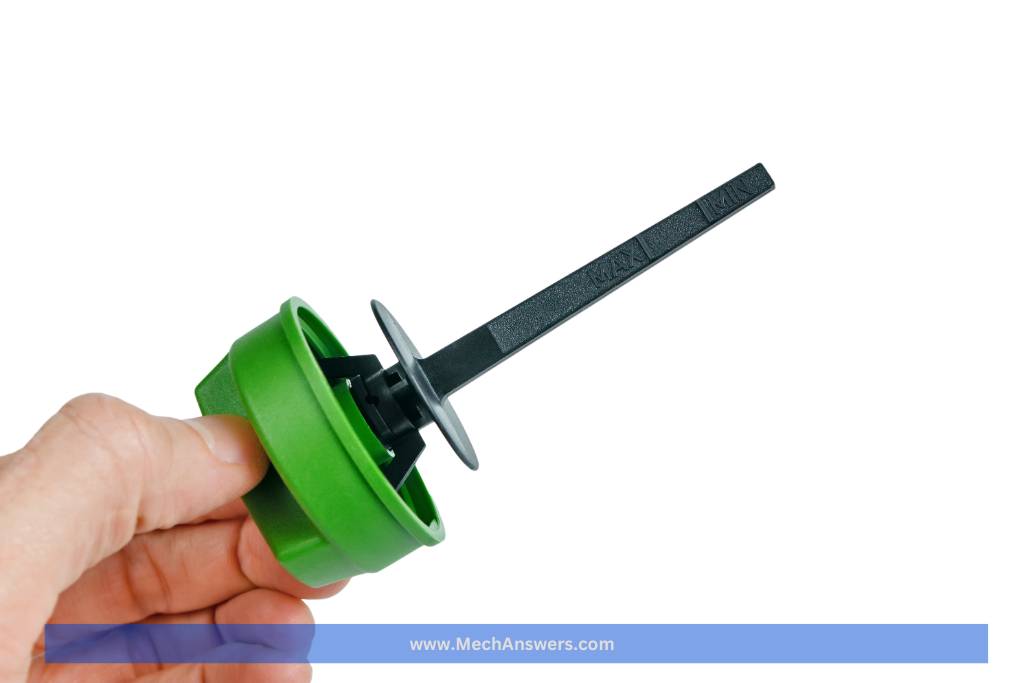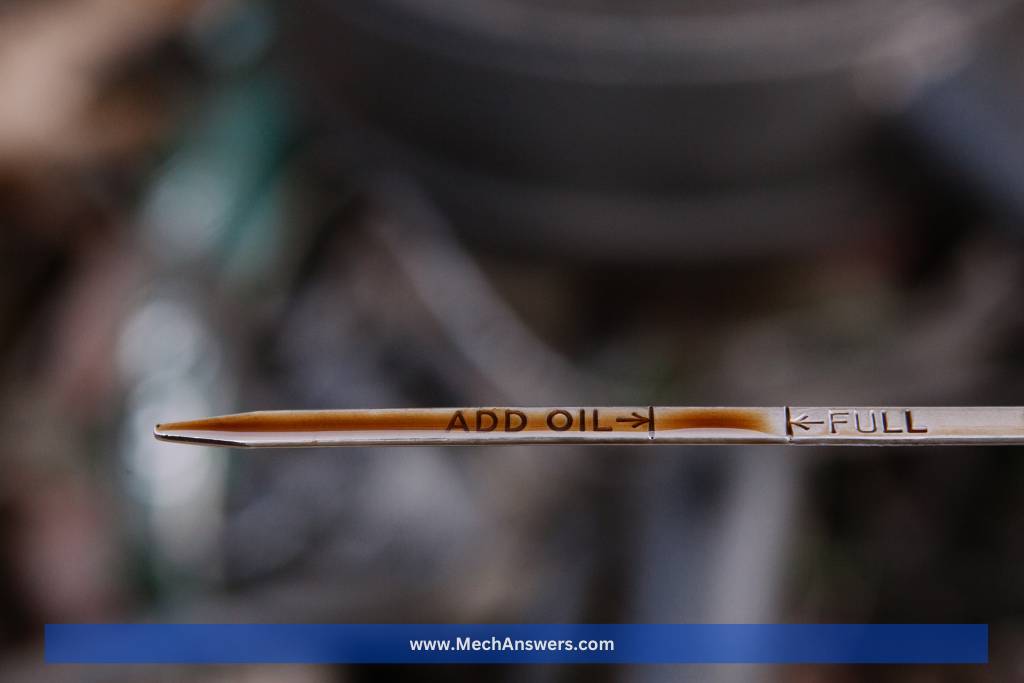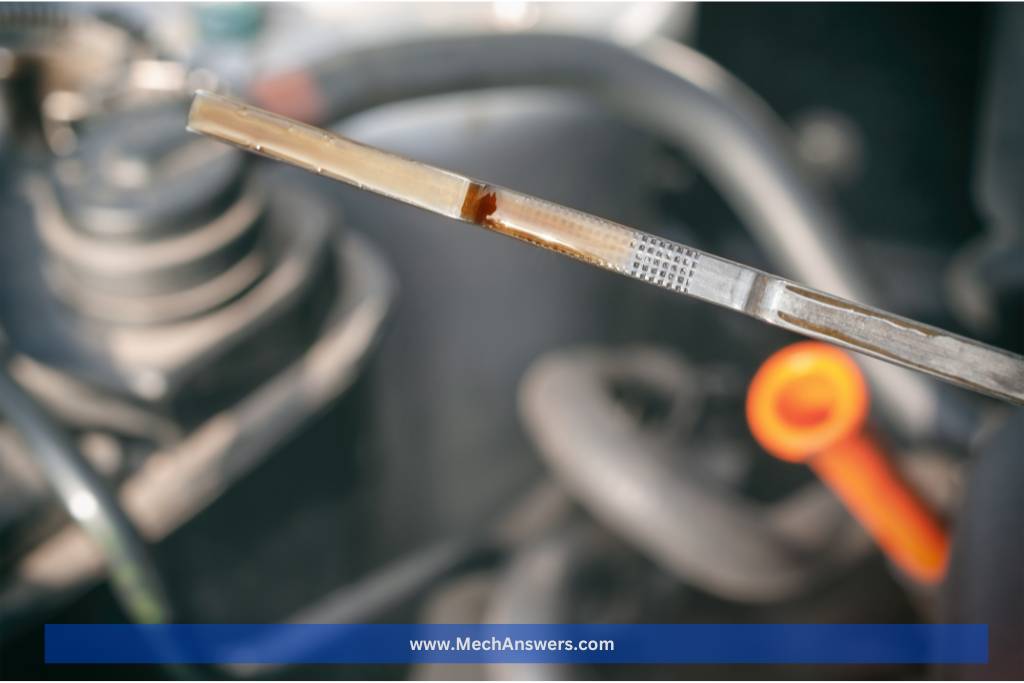Ever asked yourself, or searched for, “How Much Oil Is Too Much On The Dipstick?” It’s a common query among drivers looking to understand proper vehicle maintenance. Well, you needn’t search further, as we’re about to delve into this question.
So, how much oil is too much on the dipstick? Too much oil, typically indicated by the oil level reading above the ‘MAX’ or ‘F’ mark on your dipstick, can lead to a range of issues, from reduced fuel efficiency to potential engine damage.
Why read on? By fully understanding the implications of overfilling your vehicle’s oil, you can ensure optimal performance and longevity for your engine.

Table of Contents
How to Properly Check the Oil Level on the Dipstick
Checking the oil level correctly is pivotal for your vehicle’s health. Using the dipstick, ensure the engine is off and cool, wipe it first, dip it back in, and read the oil level against the marked notches.
Overview:
- Importance of Accurate Oil Levels
- Pre-Check Preparations
- Wiping and Inserting the Dipstick
- Reading the Dipstick
- Signs You’ve Overfilled
- The Aftermath of Overfilling
Importance of Accurate Oil Levels
Oil: It’s the lifeblood of your vehicle. Without the right amount, you’re cruising for a bruising, risking both performance and engine health. Having an optimal oil level ensures smooth engine operation. Too little and you risk overheating, but too much? That’s a slippery slope leading to engine damage.
- Key Point: Proper oil levels are crucial for optimal engine performance and longevity.
Pre-Check Preparations
Before you dive right in, there’s a bit of groundwork. First things first, park your car on a level surface to get an accurate reading. Wait for a cool engine, as hot oil expands and can mislead your reading. A cooled-off engine and a leveled ground set the stage for a precise check.
- Key Point: For accuracy, always check the oil on level ground with a cool engine.
Wiping and Inserting the Dipstick
With your gloves on, pull out the dipstick and wipe away any oil. This ensures no old oil skews the reading. Reinsert the stick, pushing it all the way in. Wait for a moment; allow the oil to settle on the stick. Now, pull it out again for the reading.
- Key Point: Wipe the dipstick clean and reinsert fully before the final pull for a reading.
Reading the Dipstick
Here’s the moment of truth. On the dipstick, you’ll spot two notches or marks. Your oil level should be between these. If it’s near the top mark, you’re golden. Nearing the bottom? Time for a top-up. Remember, the Goldilocks rule applies here; not too much, not too little, but just right.
- Key Point: The oil should sit between the two notches on the dipstick for optimal levels.
Signs You’ve Overfilled
So, you’ve been a tad overenthusiastic with the oil can? Overfilling symptoms include white smoke from the exhaust, oil leakage, and a frothy, milkshake-like substance under the oil cap. These are warning bells, signaling it’s time to drain some oil.
- Key Point: White exhaust smoke and oil leaks are red flags for overfilled oil.
The Aftermath of Overfilling
Overflowing oil can be more damaging than you might think. It could lead to higher oil pressure, blowing out seals, or even foaming up, reducing its efficiency. The key takeaway? Always aim for precision when it comes to your car’s lifeblood.
- Key Point: Overfilling leads to increased oil pressure, seal blowouts, and reduced lubrication efficiency.

How Much Oil Is Too Much On The Dipstick?
Overfilling your engine with oil can be detrimental to its performance and longevity. Always ensure that the oil level sits between the two notches or marks on the dipstick for optimal functionality.
Overview:
- Recognizing Overfill on the Dipstick
- Causes of Overfilling
- How to Correct Overfill
- Tips for Accurate Measurement
Recognizing Overfill on the Dipstick
Ah, the dipstick – a simple yet indispensable tool for any vehicle owner. Its primary purpose? To reveal the quantity of oil that’s lubricating the engine’s internals. Now, to the untrained eye, it might look like just another stick, but there’s a method to its madness. Here’s how to navigate its readings:
- Markers/Notches: First and foremost, look out for the two distinct markers or notches on your dipstick. These are essentially the “min” and “max” levels. The area in between represents the safe and ideal zone for engine oil volume.
- Color and Consistency: While we’re primarily focusing on the quantity, it’s worth noting the oil’s appearance. Fresh oil often has a clear, amber hue, while older oil might look blackish. If the oil looks frothy or has a milky hue, that’s an alarm bell indicating potential coolant contamination.
- Beyond the Brim: When you extract the dipstick, and the oil level rises above the upper marker, that’s a red flag. This indicates that there’s too much oil. An overfilled engine won’t necessarily lead to immediate damage, but it’s best not to push your luck.
- Why the Exact Level Matters: The space above the oil allows for expansion that occurs due to the heat in a running engine. If there’s too much oil, there’s no room for this expansion, leading to increased pressure within the engine. This can harm seals, and gaskets, and even lead to oil entering parts of the engine where it shouldn’t.
- Key Point: Recognizing overfill involves keen observation of both the oil level concerning the dipstick’s markers and noting its appearance for signs of contamination or aging.
Causes of Overfilling
Overfilling the engine oil can stem from a variety of reasons:
- Simply adding too much during a refill, perhaps getting distracted and missing the signal to stop.
- Misinterpreting the dipstick, especially if it’s smudged with old oil.
- Relying on an incorrect measurement as mentioned in the vehicle’s manual. While human error is a common reason, occasional mechanical mishaps can also be the cause.
- Key Point: Overfilling often arises from inattentiveness during the refilling process, misreading the dipstick, or adhering to incorrect measurements.
How to Correct Overfill
If you’ve realized that there’s too much oil, there’s no need to hit the panic button just yet. The initial step is to remove the surplus oil, ensuring the level settles back between the dipstick markers.
If doing this on your own seems daunting, seeking a mechanic’s expertise is advisable. Addressing the issue without delay is crucial, as operating an engine inundated with excessive oil can lead to complications.
- Key Point: Correcting overfill involves draining the superfluous oil or getting a professional to handle it.
Tips for Accurate Measurement
Accuracy is of the essence when measuring engine oil. To get a precise reading:
- Position your vehicle on even ground.
- Ensure the engine is cool prior to checking.
- Wipe off the dipstick before reinserting it for a reading. Adding the precise amount of oil is paramount for the engine’s peak operation.
- Key Point: For an accurate oil measurement, inspect on a level surface with the engine cooled down, and always clean the dipstick prior to rechecking.
Is It OK If Oil Is A Little Over Full?
Sometimes life gives us more than we ask for, much like a tad extra oil in the engine. A smidge above the full line might seem harmless, and truly, a slight overfill isn’t typically catastrophic. Engines can often tolerate this tiny excess without batting an eyelid.
However, over the long haul, letting this slide repeatedly can be a slippery slope to engine trouble. While a marginal overfill once in a blue moon might not make your engine throw a fit, making it a habit can spell future complications.
- Key Point: Engines can tolerate slight overfills, but consistently exceeding the mark is a risky game.
What Does A Dipstick Look Like With Too Much Oil?
Imagine pulling out a dipstick that looks like it took a long swim in a pool of oil. When there’s too much oil, the dipstick won’t just show oil levels past the upper marker. It can seem drenched, sometimes even in areas that usually stay clean.
Think of it as a coffee cup filled to the brim; any more and it’s spilling over. If the dipstick looks like it went for an extra dip in the oil pool, beyond its markers, it’s hinting at an overfill.
- Key Point: A saturated dipstick, especially beyond its typical indicators, screams “too much oil!”
What Happens If You Slightly Overfill Your Oil?
Slightly overfilling the engine oil might seem like a trivial hiccup, but even such minor mishaps can cast a shadow over time. The engine may seem to purr along just fine, but internally, the excess oil can raise the pressure.
This could lead to oil pushing its way into areas it shouldn’t. And over time? That could translate to reduced engine efficiency, and no one wants that. A minor overfill today might not make headlines, but over time, it can be the villain behind reduced engine performance.
- Key Point: Minor overfills might not spell immediate doom, but they can brew trouble over time.
Can You Slightly Overfill the Engine Oil?
Well, you can, but should you? It’s akin to having that extra slice of cake when you know you’re full. It’s tempting and might not seem problematic at the moment, but make it a habit and watch the repercussions roll in.
Consistently overfilling, even slightly, can stress the engine out and shorten its lifespan. Occasionally overstepping the oil limit might not be the end of the world, but doing it often dances on the edge of danger for your engine.
- Key Point: Occasional slight overfills might be forgiven, but regular excess can cut an engine’s life short.

What Are the Consequences of Overfilled Engine Oil?
Overfilling your engine with oil can lead to a multitude of complications ranging from decreased performance to severe engine damage. Addressing this overfill promptly can save you a lot of heartache and a hefty repair bill down the line.
Overview of the Topic
In this enlightening dive, we will cover:
- The Pressure Build-up Dilemma
- Frothing of Engine Oil
- Compromised Catalytic Converter
- Seal and Gasket Issues
- Reduced Engine Performance
- Overheating and Increased Friction
Let’s dive right in, shall we?
The Pressure Build-up Dilemma
Every engine compartment is designed to handle specific pressures. When you overfill the engine with oil, the excess oil occupies the space meant for air and vapors.
This can lead to a significant increase in pressure within the crankcase. This excessive pressure may push engine oil into parts of the engine where it doesn’t belong, like the combustion chamber.
- Key Point: Overfilled oil leads to unwanted high pressures which can push oil into unintended engine parts.
Frothing of Engine Oil
Engines are designed for the crankshaft to dip into the oil sump and splash oil around, ensuring every component gets the lubrication it needs.
However, too much oil can cause the rotating crankshaft to churn the oil into a froth. Frothy oil can’t lubricate the engine effectively, leading to increased wear and tear.
- Key Point: Excess oil gets churned into a frothy mix, compromising its lubrication properties.
Compromised Catalytic Converter
Believe it or not, overfilling can lead to engine oil being burnt in the combustion chambers. This burning releases oil particles that can clog your catalytic converter, an essential component of your vehicle’s exhaust system.
A compromised catalytic converter will not only reduce engine performance but can also lead to more harmful emissions being released.
- Key Point: Overfilled oil can harm the catalytic converter, affecting performance and increasing emissions.
Seal and Gasket Issues
With the increased pressure from the excess oil, the engine’s seals and gaskets may be forced to bear the brunt. They could be pushed out of their intended positions or even break, leading to oil leaks. Repairing or replacing these parts can be a cumbersome and expensive affair.
- Key Point: Overfilling strains seals and gaskets, potentially causing oil leaks.
Reduced Engine Performance
Engines thrive on balance. Too much oil can bog down parts of the engine, causing reduced efficiency. Your car might experience sluggish performance, poor fuel economy, and increased emissions.
- Key Point: Engine performance takes a hit with overfilling, leading to decreased efficiency and increased fuel consumption.
Overheating and Increased Friction
Oil is meant to cool and lubricate. However, when there’s too much, it can lead to increased friction as moving parts wade through the excess. This extra resistance can cause your engine to overheat, leading to potential long-term damage.
- Key Point: Overfilled engine oil can cause overheating due to increased friction between moving parts.
How to Remove Excess Oil from the Engine
Realizing you’ve poured too much oil into your engine is a panic-worthy moment for many. Don’t fret! Removing the excess oil is a straightforward process if you follow the right steps and take precautions.
Overview of the Topic
Delving deeper into this process, we’ll discuss:
- Preparing for the Task
- Using a Fluid Extractor
- The Traditional Oil Drain Method
- Checking the Oil Level Post-Extraction
- Precautions to Remember
Time to roll up those sleeves and get to work!
Prepping the Scene
Let’s start with a smooth setup. Gathering the tools is the first order of business. Slip on those gloves and safety glasses – safety first, after all!
While a fluid extractor or a simple drain pan could be your main tool, never underestimate the power of a clean cloth. Accidental spills are a part and parcel of such jobs, and being prepared for them makes all the difference.
- Key Point: Setting the stage right makes the task at hand smoother and safer.
Opting for the Fluid Extractor
For those who dread the idea of crawling under the car, a fluid extractor is a godsend. It’s all about ensuring the engine is cool, popping open the oil filler cap, and introducing the extractor tube to the depths of the oil pan.
Then, it’s mostly about following the device’s instructions, letting it suck out the oily excess. This method is notably less messy and can be surprisingly swift.
- Key Point: The fluid extractor is your mess-free, efficient buddy for removing excess oil.
Embracing the Traditional Drain
But, hey, some of us are old souls who find solace in the tried-and-true. The traditional method is a more tactile affair. With the car on even ground, protective gear on, and a drain pan in position, the adventure begins.
Unscrewing the drain plug lets the oil flow out, a stream of over-enthusiasm being corrected. Once the excess has been drained, remember to seal the deal by securely replacing the plug. This method is reminiscent of a complete oil change, embracing a more hands-on approach.
- Key Point: Traditional oil draining might demand more effort, but it’s a tried-and-true method.
Double-checking the Deed
Once you’ve done the deed, don’t be in a rush to pat yourself on the back just yet. It’s vital to recheck the oil level. Slide in that dipstick, and ensure that the oil level now comfortably sits between the minimum and maximum indicators.
Still too high? Well, it might be round two for you. A recheck is a simple step, yet it stands as a guardian against potential engine troubles.
- Key Point: A post-extraction oil level check ensures the engine sails smoothly in the safe zone.
Not Just a Task, but an Art of Precaution
There’s an art to everything, even engine oil extraction. Always wait for the engine to cool down before starting. Overager with the drain plug? Ease up, as overtightening might just strip the threads.
And of course, never forget that the environment is a silent spectator. Dispose of the excess oil responsibly. These seemingly small precautions are the brushstrokes that complete the picture.
- Key Point: It’s not just about removing excess oil; it’s about doing it with care, precision, and responsibility.
Too much oil in your engine? See what happens – How much is too much? >> Check out the video below:
Related Articles
Read more >> 5W30 vs 10W30: A Detailed Comparison with Pros and Cons!
Read more >> 5W20 vs 5W30: A Detailed Comparison With Pros And Cons
Read more >> Can I Use 5W30 Instead of 5W20? Safety & Consequences
Read more >> Can I Use 10W30 Instead of 5W30? Safety & Consequences
Read more >> Can I Use 10W40 Instead of 5W30? Safety & Consequences
Read more >> Can I Use 10W40 Instead Of 10W30? Safety & Consequences
Read more >> Can Low Oil Cause Overheating? 12 Causes & Solutions
Read more >> Why Does My Dipstick Shows No Oil After Oil Change? (Facts!)
Read more >> Can The Wrong Oil Cause Overheating? Simply Explained!
Conclusion
Understanding how much oil is too much on the dipstick is crucial for maintaining the health and performance of your engine. Overfilling the engine with oil can lead to a range of issues, including decreased engine performance, increased oil consumption, and potential damage to engine components.
By regularly checking the oil level on the dipstick and ensuring it remains within the recommended range, you can prevent the risks associated with excessive oil levels.
If you accidentally overfill the engine, it is important to drain the excess oil promptly to restore the proper oil level. Remember, maintaining the correct oil level is key to preserving the longevity and efficiency of your engine, ensuring a smooth and reliable driving experience.

